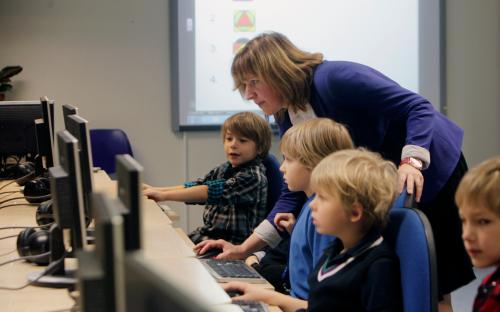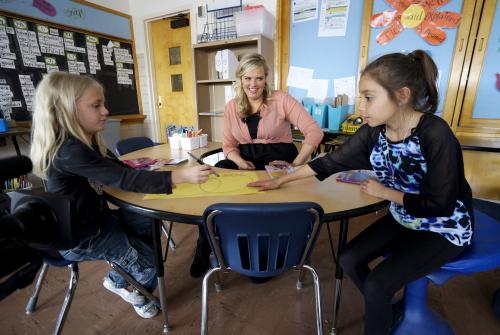This is the final piece in a four-part blog series on the assessment of 21st century skills. In this blog, we shift to considering the viability of EdTech (education technology) solutions in technology-equipped environments.
The concept of individualized learning is as old as teaching itself. We all want to acknowledge the uniqueness of each child, “meet each student where she is” and help her “be the best she can be.” Thus, it seems only natural to take the advantage of technology and democratize this pedagogical model: let’s provide each child with the quality resources that target the child’s needs. Motivated by fairness and accessibility, personalized digital learning in the classrooms has become a topic of interest, and many sophisticated intelligent learning environments have been created to provide individual students with an appropriate level of tutoring, challenge, and engagement that will level the playing field for all students. Companies like Smart Sparrow, Knewton, Carnegie Learning, and ASSISTment have developed systems for both higher education and K-12 that can be used to support students’ learning, especially in conjunction with the instructors’ involvement.
These intelligent learning environments seem promising, but are personalized digital learning experiences and technology the be-all and end-all of teaching and learning? Not so fast.

Challenges for EdTech in the Classroom
Schools are already investing in the quality of digital learning experiences; however, the use of technology in schools come with risks. And many educators and parents are concerned:
“…we were tasked with the never-before-done vision of individualizing every child’s education. The workload was immense and unsustainable, and even when I felt like I was doing what we set out to do—curate educational playlists of cards that were specifically chosen for them—I didn’t feel like it was entirely effective. It was isolating with every child working on something different; it was impersonal with kids learning basic math skills from Khan Academy; it was disembodied and disconnected, with a computer constantly being a mediator between my students and me.” – Paul Emerich, Third Grade Teacher and National Board Certified Educator in Chicago
Many researchers are also unhappy with the EdTech driven learning systems. Here are some of the issues that the measurement community has identified:
1. There is not enough attention paid to the quality of measurement—the reliability, validity, and statistical rigor of these new systems. Many of the EdTech learning solutions appear not to have incorporated the traditional measurement and psychometrics standards in their environments, and many have not yet incorporated the science of learning.
2. There is still little validity evidence that these systems work in the way they are supposed to work and little understanding of whether there are (unintended) consequences of the over-use of technology in the classroom. We need to emphasize (and sometimes dissuade those who say otherwise) that most of these systems are not designed to replace the teacher in the classroom, but to complement and empower the teacher. The systems should be used by the students when they don’t have access to a teacher, when they do their homework, or when the teacher needs to differentiate instruction.
3. We also need to understand better what it means to support the student through self-directed learning when alone, and what it means to support the teacher to support the student when in the classroom.
Potential Solutions
So, what’s being done to address these concerns?
- On the measurement side, the concept of computational psychometrics, which brings together psychometric theory and data-driven algorithms, has been developed to improve the measurement of skills in complex learning and assessment systems.
- Another direction of work is to ensure that the design of the system addresses the learner’s needs and is authentic, contextual, and timely. In other words, we are aiming to change the learning and assessment digital experiences by providing highly interactive and adaptive learning experiences, such as teaching and assessing socio-emotional skills, exploring dangerous chemicals in a simulated lab, or taking virtual field trips in space that keep the learner engaged, while collecting the evidence about the learner’s progress.
- In one of our own learning and assessment systems prototypes, called the ACTNext Educational Companion App, we designed a “pocket” guide, that provides answers and recommendations to learners on improving both the academic skills and socio-emotional skills. Unlike other EdTech solutions used in the classroom, the Educational Companion App is designed based on psychometric principles and uses cognitive diagnostic models and learning progressions for specific learning goals that are rooted in the evidence centered design. This is an example of a learning environment that uses a blended pedagogical model: it is meant to rely on self-directed learning for some activities, on the automatic adaptive recommendations from the system for some goals, and on teacher-directed learning for other activities; it also sends notifications and reports to the teachers and counselors on some aspects of the holistic learning process.
We are still working on identifying the best mechanisms for supporting the teachers and students. The educational resources available to students are curated and free, provided by the OpenEd. We are also developing ways for students to share their progress with others and to collaborate with peers on specific assignments, thereby incorporating a social component.
Conclusion
The quality of digital instruction and its integration with teacher led instruction is the future of education. With a comprehensive design process that includes learning and pedagogical sciences, and with the right technology, we can develop high-quality virtual learning and assessment experiences that meet the psychometric standards, take advantages of the interactivity and engagement afforded by the digital medium and empower the teachers. It takes an interdisciplinary team to develop systems like these and it takes commitment to quality and equity of instruction for all. We need engagement from educators and school leaders in creating and deploying EdTech resources into the classrooms if these solutions are to work.






Commentary
EdTech in the classroom: Friend or foe?
February 27, 2018